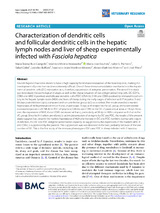Mostrar el registro sencillo del ítem
Characterization of dendritic cells and follicular dendritic cells in the hepatic lymph nodes and liver of sheep experimentally infected with Fasciola hepatica
| dc.contributor.author | Ruiz-Campillo, María Teresa | |
| dc.contributor.author | Molina-Hernández, Verónica | |
| dc.contributor.author | Bautista Pérez, María José | |
| dc.contributor.author | Pacheco, I.L. | |
| dc.contributor.author | Zafra Leva, Rafael | |
| dc.contributor.author | Buffoni Perazzo, Leandro | |
| dc.contributor.author | Martínez-Moreno, Francisco Javier | |
| dc.contributor.author | Martínez Moreno, Álvaro | |
| dc.contributor.author | Pérez, José | |
| dc.date.accessioned | 2024-02-08T19:10:04Z | |
| dc.date.available | 2024-02-08T19:10:04Z | |
| dc.date.issued | 2020 | |
| dc.identifier.issn | 1297-9716 | |
| dc.identifier.uri | http://hdl.handle.net/10396/27323 | |
| dc.description.abstract | Fasciola hepatica has been shown to have a high capacity for immunomodulation of the host response, making the development of protective vaccines extremely difficult. One of these immunomodulation mechanisms is the impairment of dendritic cells (DC) maturation and, therefore, suppression of antigenic presentation. The aim of this study was to evaluate the pathological changes as well as the characterization of two antigen presenting cells, DC (CD1b, CD83 and MHC-II positive) and follicular dendritic cells (FDC) (CNA.42, S100 and CD83 positive) by immunohistochemistry in the hepatic lymph nodes (HLN) and livers of sheep during the early stages of infection with F. hepatica [9 and 18 days post-infection (dpi)], compared with an uninfected group (UC) as a control. The results revealed a marked hyperplasia of HLN germinal centres at 9 and, in particular, 18 dpi, with respect to the UC group, with coincidental increased expression of CNA.42 in FDC of lymphoid follicles and CD1b in the DC of paracortical areas at 18 dpi. However, the expression of MHC-II and CD83 decreased at 9 and, particularly, at 18 dpi in HLN compared with that in the UC group. Since both markers are related to active presentation of antigens by DC and FDC, the results of the present study suggest that, despite the marked hyperplasia of HLN and increase in DC and FDC numbers during early stages of infection, the DC and FDC antigenic presentation capacity, as suggested by the expression of the markers MHC-II and CD83, is suppressed by the parasite. This suppression was not observed in the liver, probably because of the low number of DC. This is the first study of the immunophenotype of DCs and FDC in sheep infected with F. hepatica. | es_ES |
| dc.format.mimetype | application/pdf | es_ES |
| dc.language.iso | eng | es_ES |
| dc.publisher | Springer | es_ES |
| dc.rights | https://creativecommons.org/licenses/by/4.0/ | es_ES |
| dc.source | Ruiz-Campillo, M.T., Molina-Hernández, V., Bautista, M.J. et al. Characterization of dendritic cells and follicular dendritic cells in the hepatic lymph nodes and liver of sheep experimentally infected with Fasciola hepatica. Vet Res 51, 33 (2020). https://doi.org/10.1186/s13567-020-00757-1 | es_ES |
| dc.subject | Fasciola hepatica | es_ES |
| dc.subject | Sheep | es_ES |
| dc.subject | Immunophenotype | es_ES |
| dc.subject | Dendritic cells | es_ES |
| dc.title | Characterization of dendritic cells and follicular dendritic cells in the hepatic lymph nodes and liver of sheep experimentally infected with Fasciola hepatica | es_ES |
| dc.type | info:eu-repo/semantics/article | es_ES |
| dc.relation.publisherversion | https://doi.org/10.1186/s13567-020-00757-1 | es_ES |
| dc.relation.projectID | info:eu-repo/grantAgreement/EC/FP7/265862 (PARAVAC) | es_ES |
| dc.relation.projectID | info:eu-repo/grantAgreement/EC/H2020/635408 (PARAGONE) | es_ES |
| dc.relation.projectID | Gobierno de España. AGL2015-67023-C2-1-R | es_ES |
| dc.relation.projectID | Gobierno de España. IJCI-2017-31366 | es_ES |
| dc.rights.accessRights | info:eu-repo/semantics/openAccess | es_ES |

